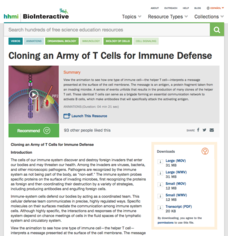Exploratorium
How Does Soap Inactivate Coronaviruses?
Washing hands is a simple way to stop the spread. Viewers watch a short video on why it is important to wash hands to curtail coronaviruses. The presenter provides an explanation of how soap and alcohol disrupt the membrane of a virus,...
Howard Hughes Medical Institute
Cloning an Army of T Cells for Immune Defense
How do bodies fight infections and illnesses? An animation of the way T cells clone to fight an infection provides many details. The resource also provides an excellent written introduction and ideas for how to ensure pupils understand...
Amoeba Sisters
Inside the Cell Membrane
Without the cell membrane, our cells just couldn't keep it together! What else does this multifunctional membrane do? Take a deeper look at the fluid mosaic model using a video from an expansive biology playlist. Topics include embedded...
Amoeba Sisters
Introduction to Cells: The Grand Cell Tour
Ready to begin cell biology in a grand fashion? Start the adventure using a short but thorough video from a vast biology playlist! From prokaryote to eukaryotes, Golgi to chloroplast, the narrator guides viewers through the cell membrane...
Amoeba Sisters
Cell Membranes and Cell Transport
Cells are busy places! How do things move around in such a tiny environment? Introduce young life scientists to the types of cellular transport through a video that is part of a large biology playlist. Animated characters demonstrate how...
Crash Course
The Nervous System – Action! Potential! (Part 2)
There are about 100,000 chemical reactions happening in your brain every second to help you sense and respond to the world around you. After a brief review of electricity, the narrator explores the action potential neurons used to sense...
Crash Course
In Da Club - Membranes and Transport
Wouldn't it be great to learn about cells through osmosis? Introduce learners to the different mechanisms of active and passive transport with a video that shows how the different transports occur across the cell membrane,...
Bozeman Science
Lipids
An informative video goes in depth about lipids, or fats. It describes the importance of cell membranes and hydrocarbon tails that contain the energy available for life. It also explains the construction of phospholipids and...
Bozeman Science
Cell Membrane
How in the world is a musk oxen like a phospholipid? Learners see the fluid mosaic model and all of its complex parts: phospholipids, proteins, glycoproteins, glycolipids, and cholesterol. The video then focuses on the phospholipid's and...
Amoeba Sisters
Homeostasis (and the Cell Membrane King)
The homeostasis pose is a popular yoga pose, and a video will explain how to do it properly. It also covers why we shiver, why we sweat, and the difference between a cell wall and a cell membrane.
Amoeba Sisters
Prokaryotes and Eukaryotes
Why does the mushroom go to every party? Because he's a fungi. The video covers prokaryotes and eukaryotes using real-life examples like fungi. It also offers an explanation of why the cell membrane and the cell wall are different.
Ricochet Science
The Semipermeable Membrane
Is it all about concentration? Explore the description of a semipermeable membrane with a video highlighting illustrations of the membrane and its function. See how concentrations of molecules move back and forth across the...
Ricochet Science
The Endomembrane System
Has your class wondered about the eccentricities of the endomembrane system? A video segment helps pupils investigate the nuclear membrane, smooth and rough endoplasmic reticulum, and Golgi apparatus.
Curated OER
Plant and Animal Cell Overview: The Basics
George Wolfe explains the parts of a eukaryotic cell very energetically. Surface area and volume are reviewed in order to show that a giant amoeba could not exist. Show your junior high or high school class this video to begin talking...
Curated OER
Video on Cells
Cellular transport and activity are highlighted with vivid images taken by a microscope. Some animation and other footage is shown as well to discuss the inner workings of a cell. Begin your biology class with this introduction to cells.
Bozeman Science
Bozeman Science: Cell Membranes
Paul Andersen explains how cells are selectively permeable with the help of their cell membrane. The main constituents of the cell membrane, including cholesterol, glycolipids, glycoproteins, phospholipids, and proteins are included. The...















